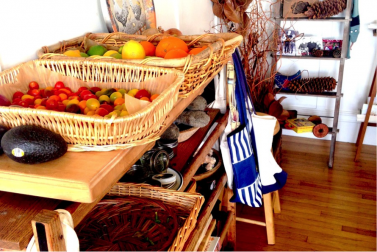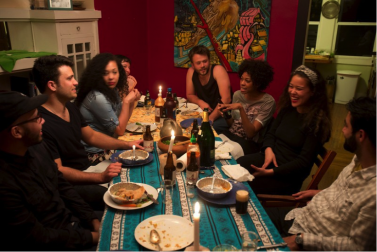Meal Sharing is the Newest Player in the Sharing Economy

Who will you meet?
Cities are innovating, companies are pivoting, and start-ups are growing. Like you, every urban practitioner has a remarkable story of insight and challenge from the past year.
Meet these peers and discuss the future of cities in the new Meeting of the Minds Executive Cohort Program. Replace boring virtual summits with facilitated, online, small-group discussions where you can make real connections with extraordinary, like-minded people.
The sharing economy is gaining momentum on the back of social and economic trends: the recession incentivizing sharing resources instead of owning goods, technology enabling transparency and social connection, and climate change increasing awareness about resource consumption. More and more organizations are popping up focused on collaborate consumption. Fast Company estimates the sharing economy as a $2 billion industry. In urban environments, the sharing economy is dissolving the line between private and public spaces. Bedrooms are becoming distributed hotels via Airbnb and personal cars are becoming taxis via Lyft, Sidecar, and UberX. Looking ahead, the next private space that will transform is the kitchen.
Around the globe, innovative online platforms are connecting ordinary people who enjoy cooking to guests who want to eat home cooked meals. Kuala Lampur based PlateCulture enables cooks around Southeast Asia to open up their kitchens to guests. Platforms such as Paris based Cookening and Tel Aviv based EatWith focus on connecting travelers to home cooked meals while on the road, sharing culture through food. And in San Francisco, SupperShare is building community through shared meals, donating a percent of earnings to local charities.
Looking at the impact of shared economy organizations in parallel industries, the San Francisco Business Times shows that Airbnb “exceeds 10 million bookings and is used by over 50,000 renters per night.” As Airbnb’s market share increases, hotel revenues in the same markets are decreasing. Similarly, the taxi industry is locked in a battle to regulate ride-sharing companies such as Lyft, Sidecar, and Uber as they disrupt the industry. Thinking about the potential volume of meal sharing, the question is how it will impact urban food systems and the restaurant industry.
Meal sharing introduces a completely new component to the dining experience: socializing with strangers. To attend a shared meal, the guest must be interested in engaging in conversation with new people, which is actually one of the barriers for meal sharing sites to gain users. Since this is not a consideration when deciding to dine out, meal sharing might nicely compliment the restaurant industry. Meal sharing may also incentivize people who cook at home to do so more frequently, as they are able make a profit.
More interesting than the economic impacts of meal sharing is the potential it carries for urban food systems and communities. First of all, meal sharing creates time and space for people to connect offline in the most traditional way possible, over food. For guests who would otherwise be consistently eating out, eating home cooked food on a regular basis usually means a lower intake of salt and fat, improving health. There are also implications for food waste and the ability to build more resilient communities through increased social connections.
When thinking about the potential of meal sharing, SupperShare cofounder Kim Hunter says, “It can reduce food waste and leverage buying power as we’re looking to explore with SupperShare. Meal sharing in support of a shared purpose can raise financial support and community awareness. Community dinners like our Harvest Dinner at New Liberation Community Garden raised money to help the garden, which distributes fresh produce to the community and brought together a cross section of people across racial and economic lines. Food is a common denominator and an incredible tool to bring people together, which I’d say is a huge first step to addressing the multitude of challenges we face in urban environments. It’s really not about limiting ourselves to just high tech solutions but about community engagement and how food is a common denominator.
Where meal sharing differs from other shared economy services is that it acts as a catalyst for community building, supporting common causes, and intimately sharing cultures. The potential for these platforms is only limited by the creativity of the meal sharing community.
Top Photo Credit: Eilon Paz
Discussion
Leave your comment below, or reply to others.
Please note that this comment section is for thoughtful, on-topic discussions. Admin approval is required for all comments. Your comment may be edited if it contains grammatical errors. Low effort, self-promotional, or impolite comments will be deleted.
Read more from MeetingoftheMinds.org
Spotlighting innovations in urban sustainability and connected technology
Middle-Mile Networks: The Middleman of Internet Connectivity
The development of public, open-access middle mile infrastructure can expand internet networks closer to unserved and underserved communities while offering equal opportunity for ISPs to link cost effectively to last mile infrastructure. This strategy would connect more Americans to high-speed internet while also driving down prices by increasing competition among local ISPs.
In addition to potentially helping narrow the digital divide, middle mile infrastructure would also provide backup options for networks if one connection pathway fails, and it would help support regional economic development by connecting businesses.
Wildfire Risk Reduction: Connecting the Dots
One of the most visceral manifestations of the combined problems of urbanization and climate change are the enormous wildfires that engulf areas of the American West. Fire behavior itself is now changing. Over 120 years of well-intentioned fire suppression have created huge reserves of fuel which, when combined with warmer temperatures and drought-dried landscapes, create unstoppable fires that spread with extreme speed, jump fire-breaks, level entire towns, take lives and destroy hundreds of thousands of acres, even in landscapes that are conditioned to employ fire as part of their reproductive cycle.
ARISE-US recently held a very successful symposium, “Wildfire Risk Reduction – Connecting the Dots” for wildfire stakeholders – insurers, US Forest Service, engineers, fire awareness NGOs and others – to discuss the issues and their possible solutions. This article sets out some of the major points to emerge.
Innovating Our Way Out of Crisis
Whether deep freezes in Texas, wildfires in California, hurricanes along the Gulf Coast, or any other calamity, our innovations today will build the reliable, resilient, equitable, and prosperous grid tomorrow. Innovation, in short, combines the dream of what’s possible with the pragmatism of what’s practical. That’s the big-idea, hard-reality approach that helped transform Texas into the world’s energy powerhouse — from oil and gas to zero-emissions wind, sun, and, soon, geothermal.
It’s time to make the production and consumption of energy faster, smarter, cleaner, more resilient, and more efficient. Business leaders, political leaders, the energy sector, and savvy citizens have the power to put investment and practices in place that support a robust energy innovation ecosystem. So, saddle up.








0 Comments